Table of Contents
Soil Class 7 Extra Questions Science Chapter 9
Soil Class 7 Science Extra Questions Very Short Answer Type Questions
Question 1.
In how many groups the soil has been categorised? Name them.
Answer:
The soil has been categorised into four major groups, i.e.
- clay
- silt
- sand
- gravel
Question 2.
Which soil is considered to be the most fertile and used for growing crops?
Answer:
Loamy soil is the most fertile soil and used for growing crops.
Question 3.
Which type of soil absorbs more water but allows less wateMo percolate?
Answer:
Clayey soil absorbs more water but allows less water to percolate.
Question 4.
Give the formula to calculate the absorption percentage.
Answer:
The absorption percentage of water can be calculated by the formula given below
\(\begin{array}{l}{\text { Percentage of water absorb }} \\ {\qquad=\frac{\text { Amount of water absorbed (in mL) }}{\text { Amount of soil (in gm) }} \times 100}\end{array}\)
Question 5.
When we add some dry soil to the water in a glass and stir it, bubbles are observed from the soil. What causes these bubbles to raise? [HOTS]
Answer:
When dry soil is added in the water in a glass and stir it, bubbles appear. These bubbles are caused due to the air present in between the soil particles.
Question 6.
What is weathering?
Answer:
Weathering is a natural process by which huge rock is broken down into tiny particles but at a very slow rate.
Question 7.
There is shimmering of air just above the soil during hot summer day. What does the term shimmering indicate? [HOTS]
Answer:
The term shimmering means that the air shines with a slightly shaking light.
Question 8.
Draw a diagram to show the different layers of soil.
Answer:
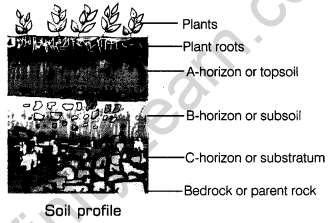
Question 9.
Name two soil types used for cultivation.
Answer:
Clayey soil and loamy soil are rich in humus and are suitable for growing plants like wheat and gram.
Question 10.
Soil has particles of different sizes. Arrange the words given below in decreasing order of their particle size. Rock, clay, sand, gravel, silt [NCERT Exemplar]
Answer:
The soil particles with the decreasing order of their particle sizes can be shown as
Rock > gravel > sand > silt > clay
Question 11.
There are two components of soil one that comes from living thing and other from non-living thing. What are these two components?
Answer:
The two major components of soil are weathered rock particles, i.e. non-living components and humus that consists of living organisms like fungi, bacteria, worm, insects, etc.
Question 12.
It is necessary to ban the use of polythene bags and plastics. Do you agree? If yes, why? [HOTS]
Answer:
Polythene bags and plastics pollute the soil as they kill the organisms living in the soil.
That’s why, it is necessary to ban the use of polythene bags and plastics.
Question 13.
List the substances which pollute the soil.
Answer:
The substances which pollute the soil are polythene bags, plastics, waste products, chemicals, pesticides, etc.
Question 14.
A special kind of soil is used for making matkas and surahis. Name it. [HOTS]
Answer:
Clayey soil is used to make matkas and surahis.
Question 15.
Explain the term humus that is generally found in the uppermost layer of soil.
Answer:
The rotting dead matter in the soil is called humus.
Question 16.
Can we make toys with the soil obtained from a field? Explain.
Answer:
No, soil from a field cannot be used to make toys. In order to make toys, the soil should be clayey.
Question 17.
The percolation rate varies from soil to other soil. Which soil would have the highest and least percolation rate?
Answer:
Percolation rate of water is highest in the sandy soil, while the lowest in the clayey soil.
Question 18.
How can a farmer convert acidic soil into neutral soil? [NCERT Exemplar]
Answer:
The farmer can convert acidic soil into neutral soil by adding a small quantity of quicklime or slaked lime solution to the soil.
Question 19.
Do all types of soil absorb water to the same extent? Give reason for your answer.
Answer:
No, it is because different types of soil has different absorbing capacity of water.
Question 20.
For planting rice, which kind of soil would be most suitable?
Answer:
For planting paddy (rice), clayey soil that is rich in organic matter and have a good water retaining capacity is ideal.
Soil Class 7 Science Extra Questions Short Answer Type Questions
Question 1.
The soil is said to be inseparable part of our life. Why?
Answer:
Soil is one of the most important natural resources. It is the uppermost layer of earth’s crust which is blackish-brown in colour. Major functions of the soil are:
- It supports plant growth by holding the roots firmly and supplying water and nutrients to the plants.
- It acts as a natural habitat for many organisms like earthworm, fungi, bacteria, ants, etc.
- It is also essential for agriculture which provides us food, clothing and shelter for all.
- It supplies water and nutrients to plants.
Therefore, we can say that the soil is inseparable part of our life.
Question 2.
Suppose certain sample takes 120 min for 960 mL water to percolate into the soil. Calculate the rate of percolation of water.
Answer:
Given, amount of water = 960 mL
Time taken to percolate =120 min
The rate of percolation will be
\(=\frac{\text { Amount of water (in } \mathrm{mL} )}{\text { Percolation time (in min) }}=\frac{960 \mathrm{mL}}{120 \mathrm{min}}=8 \mathrm{mL} / \mathrm{min}\)
Percolation rate = 8 mL/min
Question 3.
Locate the following zones given as boxed items in figure which shows a diagram of soil profile.
Topsoil, subsoil, bedrock [NCERT Exemplar]

Answer:
It is the uppermost layer of soil and is usually dark in colour because of the presence of minerals and humus in it. It provides the nutrients in plants, since the roots of most plants are confined to this layer. Humus is the dark brown coloured layer which consists of dead, rotting remains of plants and animals.

This layer of soil lies just below the topsoil. It is made up of slightly bigger rock particles than that of the topsoil. It does not have much humus and is lighter in colour than topsoil. It is somewhat harder and more compact than the topsoil. This layer is less fertile than topsoil and contains few living organisms. Subsoil is rich in minerals and iron oxides.
Below the C-horizon unweathered solid rock is found which is called as bedrock. It is non-porous and can produce the soil over a long period of time. Rainwater gets collected over it to form water table.
Question 4.
A student visits two types of field and observes that soil from field A has high percolation rate of water, while soil from field B has low percolation rate. In field B, paddy crop was grown while in field A, there was no standing crop. Name two types of soil present in two fields. [HOTS]
Answer:
Soil in field A is sandy soil while in field B soil is clayey soil which has low percolation rate and water-logging is seen. Since, paddy requires lot of standing water, therefore it is grown in field B.
Question 5.
Describe how clayey soil is useful for crops?
Answer:
Clayey soil is useful for the crops because
- it has good water retaining capacity.
- it is rich in humus.
- it is fertile in nature.
Crops like wheat and rice can be easily grown in clayey soil.
Question 6.
Read the following statements and give the appropriate terms for each of them.
(a) The process of breakdown of rocks by the action of wind, water, sunlight.
(b) Removal of topsoil during heavy rains or strong winds.
(c) Accumulation of wastes in the soil generated by human activity which alter the features of soil.
(d) The process of movement of water into deeper layers of soil. [NCERT Exemplar]
Answer:
The terms for the above described statements are as follows
(a) Weathering
(b) Soil erosion
(c) Soil pollution
(d) Percolation
Question 7.
Describe the different type of soil.
Answer:
There are three different types of soil
- Sandy soil containing sand particles in them.
- Clayey soil contains clay particles with small amount of humus in it. It is a fertile soil.
- Loamy soil is a mixture of sand, clay silt and humus. It is a fertile soil
Question 8.
Rajasthan is a desert state in India. Once while travelling to Rajasthan by train, Boojho observed several streams and rivulets of rainwater during the journey but to his surprise, he did not see streams of water in the desert region even during rains. Help Boojho to find a suitable explanation for this. [NCERT Exemplar; HOTS]
Answer:
Deserts are made up of sand, thus when the rainwater falls on land, it percolates immediately downwards in the spaces between sand particles. So, the streams of water in desert region are not visible even during rainy season.
Question 9.
A man digging a pit found that he could dig with ease initially but digging became difficult as he went deeper. He could not big beyond a depth 5 feet. Provide a suitable scientific explanations. [NCERT Exemplar; HOTS]
Answer:
The man digging a pit could dig with ease initially because of the presence of topsoil and subsoil (mainly comprising of humus and nutrients). But as he digs deeper, he finds it difficult to dig beyond a depth of 5 feet as lower layers are made up of small partially weathered rocks with cracks, crevices and with bedrock which make it hard to dig.
Question 10.
Continuously water-logged soils are disadvantageous for plant growth. Why? [NCERT Exemplar]
Answer:
Roots although underground possesses living cells that require oxygen for respiration and production of energy. They absorb oxygen that is present in the spaces between soil particles. But in water-logged soils, water occupies spaces between soil particles and pushes the oxygen out into the atmosphere. Thus, roots are deprived of oxygen and this affects the plant growth.
Question 11.
Is it a good practice to remove grass and small plants that are growing in an open, unused field? Give reason to support your answer. [NCERT Exemplar; HOTS]
Answer:
No, it is not a good practice to remove grass and small plants growing in an open, unused field because the plants cover the soil surface. Their roots bind the soil particles, holding and adhering them in place. It helps in preventing the topsoil from being washed off during heavy rain, floods and winds.
In this way, soil erosion is prevented and topsoil layer is preserved for growing more plants.
Question 12.
Observe the following figure and answer the following questions.
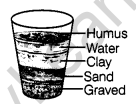
(a) Which is the heaviest rock material?
(b) Which is the lightest soil component?
(c) Why different layers of soil component are formed?
Answer:
(a) Gravel is the heaviest rock material.
(b) Humus is the lightest soil component which floats on the water surface.
(c) The soil component forms various layer one above the other according to the size of soil particle.
Question 13.
During the summer vacations, Gaurav visited his native village. He observed that farmers were using pesticides in their field. He contacted the village head and explained him the effects of such substances in causing soil pollution. Next day, the village head called a meeting of all the villagers and convinced the villagers not to use chemicals and pesticides.
(a) Why is there a ban to demand the polythene bags and plastics.
(b) List some substances which pollute the soil.
(c) What are the values shown by Gaurav? [Value Based Question]
Answer:
(a) It is because these substances pollute the soil. They also kill the organisms living in the soil.
(b) Substances which pollute the soil are a number of waste products, chemicals, pesticides, polythene bags and plastics.
(c) Alertness, responsibility and ecofriendly nature.
Question 14.
Write the difference between rate of percolation and the amount of water retained.
Answer:
Percolation property of any material is linked to its porosity. Different soils have different porosity.
Therefore, water percolates differently through different soil.
Percolation rate of water in the soil \(=\frac{\text { Volume of water percolated }}{\text { Time taken for percolation }}\)
Whereas water retaining capacity of a soil is described in terms of the amount of water absorbed by a particular type of soil. High water retaining capacity means higer water absorption.
Question 15.
Why is soil erosion relatively less in dense forests as compared to barren, open fields? [NCERT Exemplar; HOTS]
Answer:
In dense forests, the tree cover (canopy) prevents rainwater from directly falling on the ground/soil. Also roots of the vegetation bind the soil particles and hold them together. As a result, soil erosion is minimised.
But in barren, open fields, the soil is exposed to the falling rain. The soil particles become loose due to the impact of raindrops and the flow of water carries them away. The flowing water further erodes the soil surface aggravating erosion.
Question 16.
Gardeners gently dig up the soil around the roots of garden herbs (plants) frequently. Give reasons. [NCERT Exemplar. HOTS]
Answer:
A gardener often gently digs up the soil around the roots of garden plants or herbs for following reasons
- It enables easy root growth.
- For easier percolation of water.
- For aerating the soil enabling air to get into deeper layers of soil.
- For removing the weeds.
Soil Class 7 Science Extra Questions Long Answer Type Questions
Question 1.
Explain through an activity that soil has moisture in it.
Answer:
Take a plastic funnel and a filter paper. Fold the filter paper and place it in a plastic funnel. Now keep the funnel (with filter paper) in a beaker. Take some dry powdered soil and weigh it on a balance.
Note the mass of the soil taken. Now pour this weighed soil into the filter paper fixed in a funnel.
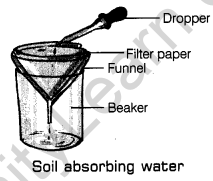
Take a measuring cylinder and fill it with water. Note the initial volume of water in the measuring cylinder. Take water from measuring cylinder with the help of a dropper and pour it drop by drop on the soil kept in the funnel. Be careful that water should not fall at one spot on the soil but should be poured uniformly all over the soil. Keep pouring water till it starts dripping from the lower end of the funnel.
Dripping of water from funnel shows that the soil taken on the filter paper has absorbed the maximum amount of water. Note the final volume of water that is left unused in the measuring cylinder.
By substracting the amount of water left in the measuring cylinder from the amount of initial volume of water taken in the measuring cylinder. We will get the volume of water absorbed by the soil which was taken on filter paper in the funnel. The difference in two reading gives the amount of water retained by the soil. The calculation can be done as follows:
Suppose, the mass of the soil taken = 50 g
Let the initial volume of water U = 100 mL
and final volume of water V = 60 mL
Therefore, the volume of water absorbed by the soil = (U- V) mL = (100 – 60)mL = 40 mL
and weight of the water absorbed by the soil = (U – V)Q = (100 – 60) g = 40 g
Therefore, the percentage of water absorbed = \(=\left(\frac{U-V}{50} \times 100\right)=\frac{40}{50} \times 100=80 \%
\)
When we perform this activity with different soil samples, we will see that.
- Sandy soil will absorb less water and allows more water to percolate.
- Clayey soil will absorb more water but allow less water to percolate.
- Sandy soil will absorb less water than clayey soil because of the large spaces between the soil particles. The area where, there is a lot of clay in the soil, stagnant water collects above the soil whenever it rains.
Question 2.
Design an activity to show the soil erosion on a barren land.
Answer:
Strong wind and rain can cause soil erosion from the barren land. This can be shown by performing an activity.
Take a wooden block and place some soil or sand on it. Keep an ice-cube tray at one end of the wooden black. Take a small battery-operated fan or hair dryer and hold it at the other end of the black near sand so that it blows the sand into the tray.
We will observe that when the fan blows it causes sand or soil particles to move and these get land in the various compartment of the ice-cube tray. This activity shows that the wind blows the soil on a barren land and may cause soil erosion.
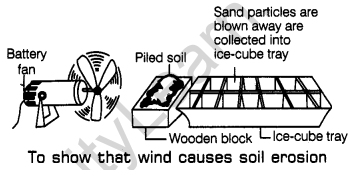
Question 3.
The contamination of soil with waste materials causes soil pollution. Does the use of pesticides in agriculture also contribute to the soil pollution? Explain.
Answer:
The contamination of soil with waste materials especially used polythene bags and plastics, pesticides, fertilisers, acid rain industrial chemical wastes, etc., is called soil pollution.
Pesticides are the poisonous chemical substances which are sprayed on standing crops to save them from the harmful insects and diseases. Some of these pesticides also mix up with the soil in the fields and pollute it. The grains, fruits and vegetables grown in this polluted soil contain pesticides. When we eat such contaminated grains, fruits or vegetables, the pesticides present in them damage our health also.
Question 4.
A soil sample was taken from an agricultural land and was weighed. The mass of the soil was found to be 50 g. 100 mL of water was taken in a measuring cylinder and added into the soil sample. The soil absorbed 80 mL of water and rest left in the measuring cylinder. Calculate the absorption rate of water by the soil. [HOTS]
Answer:
The absorption rate of water by soil can be calculated by the formula as follows:
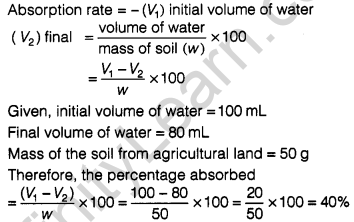
40% of the water has been absorbed by the soil.
Question 5.
(a) Soil has various important component. Write them.
(b) Arrange the following rock particles which occur in soil in the increasing order. Silt, clay, gravel, sand.
(c) Observe the following figure. What does this figure show?
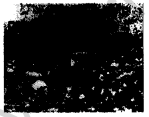
Answer:
(a) The various important component of soil are air, water, rock particles, minerals, humus and living organisms like bacteria, fungi, worms (earthworm), rodents, insects (ant and beetle), etc.
(b) The increasing order of rock particles are
Clay → Silt → Sand → Gravel
(c) The figure shows waste material like polythene bags, plastics, glass and metal objects are dumped which causes soil pollution.
Question 6.
In towns and cities, generally, the borewells have to be dug very deep to get water as compared to borewells dug in villages. Give suitable reasons. [NCERT Exemplar; HOTS]
Answer:
The borewells have to be dug very deep to get water as compared to those in villages because
- excessive use of water depletes the groundwater.
- towns and cities have asphalted roads and vast areas of soil are concreted. As a result, rainwater cannot percolate to recharge groundwater and the groundwater level further decreases. Villages have larger areas of open soil surface and fewer asphalted roads and concrete surfaces.
Thus, larger soil surface area is available for rainwater to percolate into the soil easily and recharge the groundwater. As a result, even shallow borewells yield water.
Question 7.
Soil erosion does not occur easily where the land is covered by vegetation. Do you agree? Explain.
Answer:
Yes, soil erosion does not occur easily where the land is covered by vegetation (trees and other plants). It occurs easily in those areas of land which are not covered by vegetation (trees and other plants) or have very little vegetation. If there is vegetation on land,
- then the roots of vegetation growing in the soil bind the particles of topsoil firmly. Due to this, the blowing wind and flowing rainwater are not able to carry away topsoil and hence soil erosion does not occur.
- then much of the falling rain hits the trees and plants before it hits the soil. In this way, the cover of vegetation softens the effect of heavy rains on the soil.
Question 8.
The raw and baked soil differs from each other. How they are different? How can you prepare matkas from soil? [HOTS]
Answer:
Raw soil differs from baked soil. The raw soil is white or dull blackish coloured soil. It contains water and air in it and can be moulded.
Baked soil is the heated raw soil which lost its water molecule due to heating and becomes red. Once the soil gets heated, it cannot be moulded into other form. Clay soil is used for making matkas, toys, pots, etc. The soil is kneaded along with horse dung to make best quality of raw clay soil. This kneaded soil is then placed on the wheel and appropriate shape is given. The final shape of the material is given with hands. The pots and matkas are then kept for drying for three days. These items are baked at high temperature after drying in air and then coloured.
Question 9.
During a field trip, some students visited an agricultural farm and saw a few birds eating earthworms. They enjoyed the scene and then they also started picking and killing the earthworms for pleasure. Seeing the crowd of students in a corner, the teacher rushed to them to see the matter and objected to their action. Anshul, one of the student asked the reason.
Teacher smiled and explained him that an earthworm living in the soil is very beneficial for farmers. Anshul wondered whether there were other organisms also in the soil. The teacher appreciated him and explained.
(a) Mention the importance of earthworm.
(b) List some organisms living in soil.
(c) What are the values shown by Anshul? [Value Based Question]
Answer:
(a) An earthworm helps in making the rich humus in soil.
(b) Ant, earthworm, termites, milipede, centipede, etc.
(c) Curiosity to learn and scientific attitude.
Question 10.
A soil sample having mass of 200 g was taken from garden.This soil was dried completely in the oven and again weight. The weight of the soil now was found to be 170 g. Calculate the percentage of water or moisture content present in the sample soil. [HOTS]
Answer:
The moisture content of the soil can be calculated by the formula as follows:
\(=\frac{\text { Mass of water in soil }}{\text { Original mass of soil }} \times 100\)
Given, Original mass of soil = 200 g
Mass of soil after drying =170 g
Then mass of water in soil will
= 200 – 170 = 30 g
The percentage of water in soil will be
\(\frac{30 \mathrm{g}}{200 \mathrm{g}} \times 100=15 \%\)
Soil Class 7 Science Extra Questions Miscellaneous Questions
Multiple Choice Questions
Question 1.
B-horizon is also called as
(a) topsoil
(b) subsoil
(c) parent rock
(d) substratum
Answer:
(b) subsoil
Question 2.
The microorganisms present in the soil require moisture (water) and nutrients for growth and survival. Choose from the options below, the habitat (place) where the soil has plenty of water and nutrients. [NCERT Exemplar]
(a) Desert
(b) Forest
(c) Open field
(d) Cricket ground
Answer:
(b) Forest
Question 3.
Humus helps in making soil
(a) thick
(b) hard
(c) porous
(d) dead
Answer:
(a) thick
Question 4.
Availability of water and minerals in the soil for maximum absorption by roots is in the
(a) B-horizon
(b) C-horizon
(c) A-horizon
(d) Surface of soil [NCERT Exemplar]
Answer:
(c) A-horizon
Question 5.
Manure is added into the soil to increase its
(a) water holding capacity
(b) to increase size of soil particle
(c) to make soil well aerated
(d) to drain water from it
Answer:
(a) water holding capacity
Question 6.
The soil that can be moulded into any shape is
(a) silt
(b) sandy
(c) loamy
(d) clayey
Answer:
(a) silt
Question 7.
Soil conservation measures are mainly aimed at protecting which of the following? [NCERT Exemplar]
(a) Plants
(b) Topsoil
(c) Subsoil
(d) Soil organisms
Answer:
Soil conservation measures mainly aim at protecting topsoil which is rich in humus and nutrients making it fertile to grow plants.
Question 8.
Percolation rate is measured in unit
(a) mL/min
(b) min/mL
(c) lit/min
(d) mL/sec
Answer:
(a) mL/min
Question 9.
During hot summer days the air above the soil
(a) shimmers
(b) condense
(c) becomes dull
(d) percolates
Answer:
(a) shimmers
Question 10.
Read the following statements with reference to soil.
(i) Weathering is a very fast process of soil formation.
(ii) Percolation of water is faster in sandy soils.
(iii) Loamy soil contains only sand and clay.
(iv) Topsoil contains the maximum amount of humus.
Choose the correct statements from the above. [NCERT Exemplar]
(a) (ii) and (iv)
(b) (i) and (iii)
(c) (ii) and (iii)
(d) (i) and (ii)
Answer:
(a) Statements (ii) and (iv) are correct with reference to soil while (i) weathering is a slow process of soil formation and (iii) loamy soil consists of sand, clay and silt along with humus.
Question 11.
Soil absorbs water due to its
(a) compactness
(b) porosity
(c) hardness
(d) dryness
Answer:
(b) porosity
Question 12.
The plants that grow on the surface of earth are called
(a) vegetation
(b) fertile land
(c) crop
(d) greenary
Answer:
(a) vegetation
Fill in the Blanks
1. Soil is ……………….. part of our life.
2. Soil contains ……………….., ……………….. and countless ……………….. organisms.
3. Substance like ……………….. and ……………….. pollute the agricultural soil.
4. Weathering is a very ……………….. process.
5. Clay is the ……………….. rock particle.
6. Loam soil is a mixture of ……………….., ……………….. and with small amount of ……………….. in it.
7. Paddy requires ……………….. soil to grow.
Answers:
1. inseparable
2. air, water, living
3. chemicals, pesticides
4. slow
5. smallest
6. sand, clay, silt, humus
7. clayey
True/False
1. The removal of upper surface of soil is called soil pollution.
2. Sandy soil is used for making toys.
3. Cotton is grown in sandy-loam soil.
4. Erosion of soil is more severe in the barren land.
5. Soil is formed by erosion.
6. Silt is somewhat bigger rock particles than clay.
7. Topsoil contains humus.
8. A-horizon is also known as subsoil.
Answers:
1. False, soil pollution is when humans introduce harmful objects like polythene bags, plastics, chemicals, water products and pesticides in the soil in a way that causes harm to other living things or destroys soil ecosystem.
2. False, clayey soil is used for making toys.
3. True
4. True
5. False, the soil is formed by the breaking down of jocks by the action of wind, water and climate. This process is called weathering.
6. True
7. True
8. False, A-horizon is the uppermost layer and also known as topsoil.
Match the Columns
Question 1.
Match the Column I with Column II.
| Column I | Column II |
| (a) Soil | (i) Must be banned. |
| (b) Garden soil | (ii) Heaviest particle of soil. |
| (c) Polythene bags | (iii) Fungi, bacteria, earthworm. |
| (d) Soil profile | (iv) Unweathered solid rock. |
| (e) Gravel | (v) Deposited at river beds. |
| (f) Bedrock | (vi) Blackish-brown in colour. |
| (g) Natural habitat | (vii) Different layers of soil. |
| (h) Silt | (viii) Living organisms are ant and insects. |
Question 2.
Match the Column I with Column II.
| Column I | Column II |
| (a) Earthworm | (i) Sand and beaches. |
| (b) Garden lizard | (ii) Burrows in soil. |
| (c) Crab | (iii) Deep, narrow holes in dry soils. |
| (d) Rodents | (iv) Surface of soil. |
| (e) Scorpion | (v) Surface of shaded moist soils. |
| (f) Snails and slugs | (vi) A-horizon of moist soils. |
Answers:
1.
(a)-(vi)
(b)-(viii)
(c)-(i)
(d)-(vii)
(e)-(ii)
(f)-(iv)
(g)-(iii)
(h)-(v)
2.
(a)-(vi)
(b)-(iv)
(c)-(i)
(d)-(ii)
(e)-(iii)
(f)-(v)






